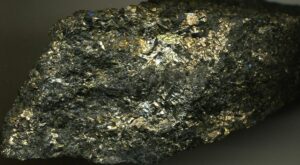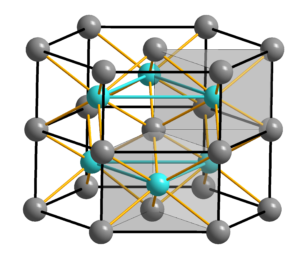This article is about is is nickel an elementt and its properties like Lewis Structure, Nickel electronic configuration, valence electrons, Orbital diagram, crystal structure, Atomic properties, Physical, chemical, and nickel isotopes.
It is an element in the transition metal family with the atomic number 28 and the symbol Ni. With an atomic weight of 58.69, Nickel belongs to the group of block elements in the periodic table. This metal is lustrous and has a sliver-white color with a golden tint. It is ductile, and hard in strength used in making coins. Nickel electronic configuration is [Ar] 3d8, 4s2.

Nickel lewis structure
With Atomic no. 28 Nickel has 2 electrons in its outermost shell. Lewis dots are drawn using the electrons in the valence shells of atoms. Lewis structure represents the dot structure of valence electrons around the Nickel.

Nickel electron Configuration
A metal’s Nickel electronic configuration is defined by how its electrons are arranged around its nucleus at different energy levels.
Atomic No. of Ni = 28
Nickel belongs to d-block elements and the outermost shell consist of 2 electrons. Nickel is a transition metal element. Nickel is represented in two electronic configurations:
[Ar] 3d8, 4s2
[Ar] 3d9, 4s1
The Symbol [Argon] is the core state and these energy levels are very close to each other so there is a transition that occurs which is called d-d transitions. But there are some arguments about it, so according to experimental proof the electronic configuration is written in its lowest energy states i.e.
Electronic configuration of Ni = 1s2, 2s2, 2p6, 3s2, 3p6, 4s2, 3d8
or
E.C = [Ar] 3d8, 4s2
What are valence electrons?
A valence electron is an electron that lies at the very outermost edge of a valence shell. Bonding and chemical reactions are carried out by electrons in the valence shell.
Ni has Atomic no. 28 having a valence shell that is 4th which consists of 2 valence electrons.
Valence electron of Ni = 2
Orbital diagram for nickel
The orbital diagram shows its pictorial distribution of electrons in the form of a picture and described it. For drawing the orbital picture of Ni two concepts should be known.
1. Hund’s rule: Every orbital is first single occupied according to its energy level, after which pairing occurs and all electrons of the same spin are in solely occupied orbitals.
2. Pauli’s exclusion principle: For all four sets of quantum numbers, there cannot be two electrons of the same atoms, no same value.
According to the electronic configuration of Nickel Ar[ 3d8, 4s2 ], its electrons are distributed in 4 orbitals. The outermost shell of nickel is 4th, so these electrons are distributed in them.

Ground state electron configuration for nickel
Generally, Nickel’s ground state electronic configuration is written as follows: E.C of Ni in ground state = [Ar] 3d8, 4s2
Ni crystal structure
An atomic no. 28 nickel consists of an FCC(Face centered Cubic) crystal structure with an atomic radius of 0.124nm.
Electronic configuration= [Ar] 3d8, 4s2
Atomic Radius = 0.124nm
Crystal Structure of Ni = FCC

The FCC crystal structure will change frequently into hcp (Hexagonal Close packing structure). An example of the Crystal structure is Nickel Arsenides
Nickel atoms at the center and Arsenide atoms surround the 6 corners of the octahedron. Cation is in gray shades and anion in light blue shades.

Nickel atomic properties
- Nickel belongs to the d-block element which is a transition metal element. According to its periodic table position, it belongs to period 4 and group 10. Because d-block elements are located between s and p-block elements, they have transition properties. It is the most abundant element that belongs to transition elements
- Atomic No. 28 and electronic configuration is [Ar] 3d8, 4s2 , it follows 18 electrons rule and having +2 covalency.
- The Variable oxidation state of Ni = -2,-1,0,+1,+2,+3,+4 (7 oxidation state)
- The most stable oxidation state of Ni is +1,+2,+3,+4. Most common oxidation state=+2.
- Its oxides are basic.
- Electronegativity of Ni =1.91, so this occurs in the form of Metal.
- The atomic radius of Ni =0.124nm.
Nickel Physical Properties
The physical properties of metal will explain through physical appearance.
- Colour of Nickel: A silvery-white, lustrous, hard, and tough metal than iron, exist in the form of pure metal and the formed alloy.
- State: Nickel is solid metal, which is blue or green. Nickel is found in the form of ores combined with iron and cobalt.
- Boling &Melting point: Nickel melts at 1453 degrees and boils at 2732 degrees Fahrenheit.
- Ores: Nickel pentlandite [(Ni,Fe)9S8], Niccolite.
- Conductance: Due to the presence of valence electrons, it is a High conductor of heat and electricity.
- Magnetism: Nickel can be easily Magnetized, so behaves like ferromagnetic. Most of the meteorites contain nickel metals.
Nickel chemical properties
The chemical properties of an element defined when it reacts chemically with other elements and there are changes occur.
- It reacts with dilute acids and dissolves slowly in ammonia
- It is high resistance in nature, therefore no rusting and corrosion occurs.
- Nickel metal does not react with oxygen directly, but it will react and ignite in the air if it is in a dispersed state.
- Used to electroplate and make alloys of nickel.
- Nickel is act as a catalyst when it reacts with organic compounds and hydrogen.
- Nickel form a compound that reacts with carbon monoxide from carbonyl compounds.
- Nickel carbonyl compound is a colourless liquid and volatile.
Nickel Isotopes
- Nickel has 5 stable and 30 unstable isotopes.
- 5 stable isotopes are 58Ni, 60Ni, 61Ni, 62Ni, and 64Ni.
- The occurs naturally abundant isotope is 58Ni (which occurs naturally at around 68.07%)
- 62Ni has a high range of nuclear energy and is used in nuclear binding energy.
- 62Ni is the heaviest isotope in the universe.
- These isotopes are helpful in the generation of some radioisotopes. There are 26 radioisotopes of nickel is present.
- 59Ni is the most stable radioisotope having a half-life is around 76000 years and some radioisotopes have a 60 hours half-life only, some are only 30 sec, so these are called meta states.
- Recently,78Ni has recorded a half-life of 110 milliseconds.
Conclusion:
Nickel Electronic configuration is important for explaining whole articles. Nickel electronic configuration tells us about its orbital diagram, and its oxidation state, and nickel electronic configuration also explains the concept of valence electrons. We will learn about the atomic properties, physical properties, and chemical properties of Nickel through nickel electronic configuration. In addition, Nickel electronic configuration will explain nickel isotopes.

Hi….I am Monika. I have done Masters in Chemistry. I am a Subject Matter Expert in Chemistry. I would say that I am a very passionate writer. The main goal of my writing is to present new perspectives. I want to discover new things that I can apply to my surroundings.
Let’s connect through LinkedIn